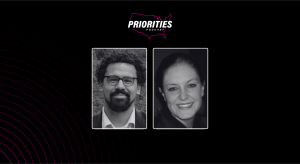How not to be a government ‘innovation bully’

Bring up chief innovation officers, and Archana Vemulapalli will become indignant.
The Washington, D.C., chief technology officer says the trendy new role creates an exclusivity and elitism that she can’t stomach. Innovation, she says, is for everyone. Her reservations are shared, though perhaps not as strongly, by many other technology leaders.
At the very least, the officials charged with leading innovating carry a heavy burden — they are expected to first of figure out what the word means and then deliver on the most hyped promise in government.
“You can’t say, ‘Oh, because you look a certain way and you have a degree and you sound cool, you’re innovative, and because I’m 70 years old and I’m going to retire in five years, I’m not cool and I can’t be innovative,'” Vemulapalli said. “At the individual level, you need to motivate everyone to be creative and think of ways in which they can drive efficiency, because when you have that, the whole organization improves. Do you honestly believe people who have been in the government for 20, 30 years are just sitting there because they haven’t tried?”
Vemulapalli noted that some of her office’s most productive ideas have come from non-managers, because they are the most knowledgeable and the culture welcomes their points of view. Innovation chiefs never have that same level of operational knowledge, she said, and they rarely stick around long enough to make a difference.
There’s a right way to innovate and then there are the “innovation bullies,” said Los Angeles Chief Information Officer Ted Ross.
“In multiple organizations I’ve seen that happen,” Ross said. “I’ve seen it on software projects, in which they bring in the project team and they’re the know-it-alls, and I’ve certainly seen it in the area of innovation. They show up and they start lecturing everybody on everything. No one likes a know-it-all, even if you know it all.”
Danger at the top
Engaging a small group with a top-down innovation assault is attractive for managers because it makes them look good, Ross said, but it comes at the cost of alienating a much larger pool of untapped talent.
“There is no ‘innovative project,'” Ross said. “You just want to have a culture of innovation in which you’re always looking for different opportunities, you’re always pushing.”
Chicago CIO Brenna Berman agreed that installing an innovation chief can prevent an organization from taking the overall mission to heart.
“It lets people off the hook for innovation,” Berman said. “It makes it one person’s job to innovate instead of the entire city government’s job to innovate.”
Berman draws heavy influence from her decade at IBM, where innovation is embedded so deeply in the culture that even the finance department is expected to search for creative new practices amid its daily work, she said. Another private sector company known for routinely pushing beyond what people thought was possible — Google — doesn’t have an innovation officer at all. Innovation doesn’t necessarily need a designated leader.
“It’s more about the way you think and how you do things — not someone who’s responsible for the innovation itself,” Berman said.
Beyond symbolism and messaging, skeptics also cite practical concerns that can lead to a lack of continuity when it comes to progressive thinking within government. At the city level, innovation offices are usually embedded in the mayor’s office and are focused on just a few select projects, which they then hand off to neighboring departments where the people who are supposed to implement the solution were sometimes not sufficiently involved in defining the project’s scope and purpose.
“Without fail, it doesn’t actually leverage the expertise of the department,” Berman said. “Someone has to implement it and usually, they haven’t involved the implementers in the definition of the innovation. You have an unnatural separation between innovation and execution.”
And most troubling, the placement of innovation offices in mayor’s offices makes them vulnerable. If a new administration removes the innovation office, some might infer that work in innovation has concluded and is no longer important.
“If you don’t operationalize innovation, if you don’t embed it in the department, it will remain a specialty,” Berman said.
Debra Lam, former chief innovation and performance officer for the City of Pittsburgh, said she’s also heard these arguments made in the context of environmental sustainability programs. But as the city’s first innovation chief, Lam said the city was aware of the challenges in creating the position and took care to circumvent them.
“For our innovation and performance, we embedded it in city code,” Lam said. “It means that even with changes of mayors and administration, you can’t just eliminate innovation and performance.”
And though an innovation chief who works out of the mayor’s office as a special adviser can in be a precarious position, Lam said, that kind of official also has the advantage of wielding the administration’s influence. Indeed, one of the federal Office of Personnel Management’s key recommendations for promoting innovation in government is for senior management to offer strong support so innovative practices can penetrate and last.
‘Weird new titles’
Fears of transient innovation aren’t hypothetical. After being elected in early 2016, Philadelphia Mayor Jim Kenney dissolved the Mayor’s Office of New Urban Mechanics (MONUM) and sunk the CIO and the Office of Innovation and Technology below the chief administrative officer. Some doubted the restructuring and questioned what the implications were if MONUM could be dissolved so easily.
Andrew Buss, director of innovation management at Philadelphia’s OIT, said its projects haven’t suffered from the restructuring. The last remaining project at MONUM, which had run out of funding, was moved to OIT, and now OIT and the chief administrative officer split technology projects on the budget. OIT tends to handle more public-facing projects like digital literacy, while operational capacity-building innovation projects tend to reside with the CAO.
Technology no longer has a seat directly inside the mayor’s office in Philadelphia, but with the CAO rallying for administrative support, innovation gets closer to the processes of departments, Buss said. And between the city’s innovation lab, innovation fund and innovation academy, Philadelphia is now doing some of its most meaningful innovation work, he said.
“I would have to imagine that a lot of the resistance and occasional resentment to innovation offices is the titles of the people in those offices,” Buss said. “They’re kind of weird new titles that people aren’t used to in government. I’m the ‘director of innovation,’ so I guess that’s tolerable in some ways to people.”
Boston CIO Jascha Franklin-Hodge said his city’s innovation efforts coming from its own MONUM are working, but warned that government needs to be careful about how to set up such an office. In Boston, the model is for innovators to serve as drivers and supporters where otherwise these changes mostly wouldn’t happen, he said.
“Innovation in an ideal world should be everyone’s job, but for many people, it’s a struggle to even get their primary job done and finding the space and time to do innovative work — especially to get to something new and better that may involve disruption to what they do every day — it can be a tall order to ask of a civil servant,” Franklin-Hodge said. “… If you have to choose between innovating and getting your workload done, you’re always going to choose your workload.”
Franklin-Hodge’s vision of an innovation office is one that offers a “safe space” for experimentation that can also absorb the risk of new ideas. It’s not about excluding anyone, he said, but recognizing that innovation is challenging and needs a special effort.
“The key in an innovation team is genuine partnership with the people who are doing the work the traditional way and engaging them in the process of developing new modes of work and experimentation, because they will bring with them this incredible wealth of knowledge and perspective about what it’s like in the real world and help make sure that innovations are actually things that have positive real-world impacts,” he said.
Rhode Island’s Office of Innovation operates in a similar fashion, says the state’s chief innovation officer, Richard Culatta. It has the luxury of his experience: From 2006 to 2010, Culatta was a learning technologies manager at CIA University, the national intelligence agency’s education unit, where his office created an innovation team. That team was supposed to dig into operations and improve things, but it ran into culture problems, Culatta said.
“Whenever there was a suggestion of doing things a different way, the response was, ‘If you want innovation, go over to the innovation team,'” Culatta said. “It was a pass for them to have to rethink any of their processes.”
Setting up for success
Rhode Island has a few rules it adopts for all of its innovation projects. All are designed to be fast — a rapid prototyping approach ensures people can see the results of their work within six months or less. Projects must take a nontraditional approach, otherwise they’re not really “innovative,” Culatta said. And, uniquely, the office will not do any work without first finding an outside entity to own the project.
“We have had cases where we think it’s a great project and it’s good to go and there’s funding on it, but we can’t find someone to be the owner of it other than us, and we pass on those projects, or at least we put them on hold until we have the right partner,” he said.
The idea isn’t to lord over anyone, Culatta said. The purpose is to offer support that allows agencies change how they work, and on their terms.
“We are really more about a culture shift in government than a lift up that we’re doing,” he said. “Most of the people we work with are legitimately excited about trying to approach it — they just don’t know what those approaches look like. So, it’s a lot of coaching, and also providing examples of what this could look like.”
After the innovation office held a hackathon with the Rhode Island Public Transit Authority, that agency is now planning its own hackathons.
“They’ve got it,” Culatta said. His office can sink into the background and only engage the transit agency when needed.
Among Rhode Island’s hefty innovation portfolio is an innovation league, a program launched this year that couples managers to work across silos. One day a week for nine months, they search for mutually beneficial processes and new insights. The idea, Culatta said, is for the innovation office to act as a catalyst that will hopefully operationalize enough innovation to put itself out of business.
Octavia Abell, director of strategy at the Office of Innovation, said participants of the innovation league and other programs relish the opportunity to collaborate in this way.
“I see that as a powerful lever,” she said, “that if you give people the space to collaborate and innovate, you can see some pretty powerful things come out of that.”
Outcomes for people, not just processes
Innovation’s fuzzy meaning has the word becoming attached to projects of many different types — they can be operational capacity projects, entrepreneurial-focused, or related to digital inclusion, open data or civic tech. But the innovation projects that are most difficult to deny are the ones that tackle social issues and deliver any CIO’s favorite outcome: big, measurable impact.
One of the first innovation offices born out of the Bloomberg Philanthropies Innovation Teams initiative, the New Orleans Innovation Delivery team (I-Team), has the distinction of being both an early innovation effort that was launched by a mayor — Mitch Landrieu launched the office in 2011 — and a program that continues to show signs to lasting influence throughout the city.
The office helped to bridge agencies as the city tackled issues like urban blight, permitting, and customer service at city hall, while adding capacity to a greater movement within government to use data to guide smarter decision-making. But the tallest feather in the team’s cap was NOLA for Life. The initiative precipitated an 18 percent reduction in the city’s murder rate from 2011 to 2015. By targeting known hotspots and gang activity, New Orleans was able to thoroughly outpace Baltimore and St. Louis during the same time period, cities that saw increases in their murder rates nearing 80 and 70 percent, respectively.
Charles West, New Orleans I-Team director from 2011 to 2016, said he took the job amid hurricane recovery efforts because he wanted to see his hometown flourish.
“I said at some point early on in my tenure that I wanted to work on big problems that matter to the city, and definitely that one (NOLA For Life) and all of them that I worked on qualify as that,” West said.
Innovation teams should exist to proliferate their work throughout government, he said, but someone also needs to be there to push forward large bodies of work. In the case of New Orleans, city government did both. West relayed anecdotes of offices throughout the city picking up on work practices and performance management strategies that were pioneered out of the I-Team office.
“I think as long as the team recognizes they both have a responsibility to achieve the outcomes but also to contribute to a greater culture of innovation,” he said, “then the team is an asset.”






